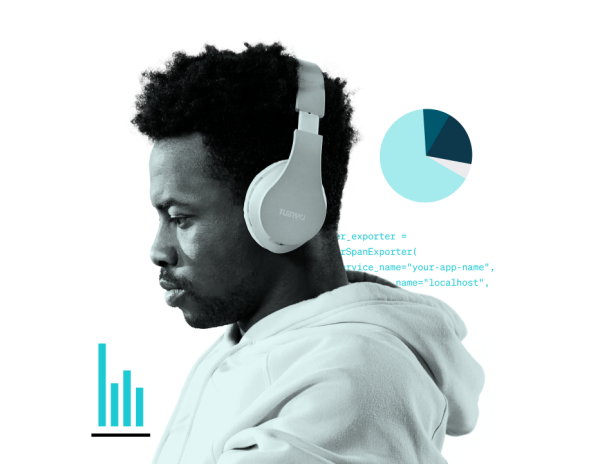We were curious about the overall primary benefits of observability, as well as the advantages of achieving full-stack observability, how much total value organizations receive from their observability investment per year, the median annual return on investment (ROI) for observability, in what ways incorporating DevSecOps in the observability practice helps improve security the most, and how observability most helps improve the lives of IT decision makers (ITDMs) and practitioners.
Observability benefits highlights:
Primary observability benefits
We found that respondents saw clear benefits as a result of their current observability solution:
- Two out of five (40%) said improved system uptime and reliability is a primary benefit—13% more than last year.
- More than a third said increased operational efficiency (38%) and Security RX (34%) were top benefits.
- About a quarter indicated an improved real-user experience (27%) and developer productivity (23%) were primary benefits.
Role insight
ITDMs were more likely to say Security RX is a primary benefit (39%) compared to practitioners (32%).
Regional insight
Asia Pacific was more likely to experience business and/or revenue growth (25%) than Europe (18%) and North America (16%).
Industry insight
Those from financial services/insurance and nonprofits were the most likely to experience increased operational efficiency (both 42%), followed by education, industrials/materials/manufacturing, and retail/consumer (40% each).
Full-stack observability advantages
Slicing the answers by respondents with and without full-stack observability (by the report’s definition) revealed that those with full-stack observability benefit from so many advantages that it warranted its own section.
| WITH full-stack observability |
WITHOUT full-stack observability |
% more likely with full-stack observability | |
|---|---|---|---|
| Experienced MTTR improvements of 25% or more | WITH35.7% | WITHOUT28.1% | % more likely with full-stack observability27.0% |
| Spent less than $250K per hour of downtime for critical business app outages | WITH42.1% | WITHOUT34.6% | % more likely with full-stack observability21.7% |
| Indicated that improved uptime and reliability is a primary observability benefit | WITH45.2% | WITHOUT37.7% | % more likely with full-stack observability19.9% |
| Detected high-business-impact outages in 30 minutes or less | WITH54.0% | WITHOUT45.5% | % more likely with full-stack observability18.7% |
| Resolved high-business-impact outages in 30 minutes or less | WITH34.0% | WITHOUT28.7% | % more likely with full-stack observability18.5% |
| Had more unified telemetry data | WITH40.7% | WITHOUT34.9% | % more likely with full-stack observability16.6% |
| Said observability is more for achieving core business goals | WITH43.2% | WITHOUT37.7% | % more likely with full-stack observability14.6% |
| Experienced high-business-impact outages 2–3 times per month or fewer | WITH66.9% | WITHOUT59.0% | % more likely with full-stack observability13.4% |
| Learned about interruptions with one or more monitoring tools | WITH78.8% | WITHOUT70.1% | % more likely with full-stack observability12.4% |
| Said that their MTTR has improved since adopting observability | WITH68.2% | WITHOUT62.5% | % more likely with full-stack observability9.1% |
Those with full-stack observability were also more likely to experience a 37% lower median annual outage cost, experience a 14% higher median annual ROI for observability, and have more strong observability advocates than those without full-stack observability.
Full-stack observability
fewer
outages
faster
MTTD
faster
MTTR
lower
outage costs
higher
ROI
Total value of observability
We asked survey-takers how much total value their organization receives from its observability investment per year and found that:
- More than half (53%) receive $500,000 or more.
- Two out of five (41%) receive at least $1 million.
- Just 11% receive less than $100,000.
Notably, respondents who said they have 5+ capabilities currently deployed were 82% more likely to say they receive $1 million or more total value per year from their observability investment than those with 1–4 capabilities currently deployed.
In addition, respondents from organizations with a mature observability practice (by the report’s definition) were 48% more likely to report receiving $1 million or more total value per year from their observability investment than those with less mature observability practices.
received $1M+ total value per year from observability
Role insight
In general, executives and practitioners were more likely to say they receive higher value from their observability investment than non-executive managers.
Organization size insight
Midsize and large organizations by annual revenue were generally more likely to receive higher value from observability than small organizations.
Return on investment for observability
Taking the annual value a step further, we calculated the median annual ROI based on annual spend and annual value received estimates.
The median annual ROI is 100% across all respondents. In other words, for every $1 spent, respondents believe they receive $2 of value. Put another way, respondents receive $2 of return per $1 of investment.
So, the median impact of observability spending is a 2x annual return in value or ROI. In other words, respondents received a 2x annual return on their observability investment.
Several factors had an even more positive impact on ROI. Respondents whose organizations had:
- Achieved full-stack observability (by the report’s definition) had a higher median annual ROI (114%) than those who hadn’t (100%).
- A mature observability practice (by the report’s definition) had a higher median annual ROI (250%) than those with less mature practices (100%).
- Five or more capabilities currently deployed had a higher median annual ROI (114%) than those with 1–4 deployed (0%).
- Five or more observability practice characteristics currently employed had a higher median annual ROI (114%) than those with 1–4 employed (100%).
Invest
Get
2xROI
annual ROI on observability investments
Regional insight
Asia Pacific had the highest median annual ROI (114%) compared to Europe and North America (both 100%).
Organization size insight
Large organizations (by annual revenue) had the highest median annual ROI (114%) compared to midsize (100%) and small (broke even) organizations.
Industry insight
Energy/utilities had the highest median annual ROI (192%), followed by education and IT/telco (both 114%). Government and unspecified broke even. All other industries had a median annual ROI of 100%.
Security improvement
We asked respondents how incorporating DevSecOps in their observability practice has helped improve security the most and found that:
- More than a third said it’s improved the security and availability of applications (38%) and collaboration with the security team (35%).
- More than a quarter (26%) said it’s provided unified security data in context alongside telemetry data, which is important for business observability.
- Just 4% haven’t adopted DevSecOps in their observability practice.
Regional insight
More respondents from North America said they haven’t adopted DevSecOps in their observability practice (7%) than Asia Pacific (2%) and Europe (4%).
Industry insight
Government and education respondents were the most likely to say they haven’t adopted DevSecOps in their observability practice (8% and 7% respectively).
Life improvement
We asked practitioners and ITDMs about the ways observability helps improve their life the most. Each had a different set of answer options (with one exception) that reflect how they engage with observability based on their roles.
- Almost half (46%) of practitioners said it increases their productivity so they can find and resolve issues faster.
- About a third of ITDMs said it helps them achieve technical key performance indicators (KPIs) (35%) and/or business KPIs (31%).
- All roles thought it makes their job easier, including 35% of ITDMs and 29% of practitioners.
said observability makes their job easier
Observability helps us solve certain issues at a larger scale, and that makes our lives easier because we have fewer things to worry about and fewer things to look into. So it definitely makes our lives simpler and easier. And it definitely reduces risk for the company.

